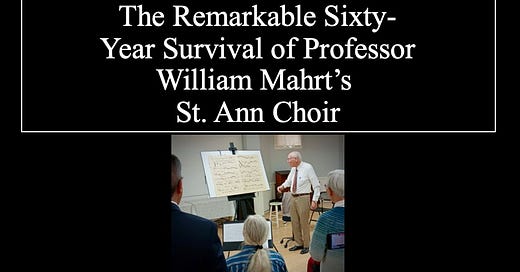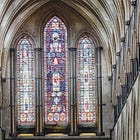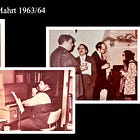Part I: "The Remarkable Sixty-Year Survival of Professor Mahrt's St. Ann Choir"
Prof. Mahrt's Remarkable Survival & Why Am I Giving This Talk?
Before I begin this talk about the remarkable survival of Professor Mahrt’s St. Ann Choir, I want to mention another remarkable survival.
In the above photo from the first slide, Professor William P. Mahrt was leading a rehearsal for the St. Ann Choir before Mass on Sunday, November 5, as he does on most Sundays. What’s remarkable is that he’d had a mild heart attack on the previous Sunday!
He’d then been operated on Monday, October 30th, and he had been released from the hospital only on Thursday, November 2, three days before the photo was taken. I heard he had a stent put in. On Tuesday, November 7, at the reception after the Solemn Vespers on the first day of the conference honoring his life work at St. Patrick’s Seminary, Fr. Mark Doherty, the seminary director, told me that Professor Mahrt had three stents put in the previous Monday. Three!
Sunday, October 29 —Heart attack
Monday, October 30—Three stents surgically inserted
Thursday, November 2—Released from Stanford Hospital
Sunday, November 5—Rehearses and leads St. Ann Choir at Sunday Mass
Tuesday, November 7—Rehearses choir members and friends for liturgies at the Musical Shape of the Liturgy conference for most of the day.
The conference began Tuesday afternoon with Solemn Vespers with Archbishop Salvatore J. Cordileone presiding. Professor Mahrt participated fully that day and for the remaining two days of the conference.
The afternoon before the conference began with Solemn Vespers, saw him coming down the hall at the seminary after hours of rehearsing the music to be sung at liturgies during the conference. He said that would be a good time to give me answers to some questions I’d emailed him earlier in the day, and we found a room with some comfortable seats and talked for about twenty minutes. I was happy to see him doing so well.
And as everyone else who saw him at the conference knows, he was strong on his feet, strong-minded, and strong-voiced. At the age of 84, less than two weeks after a heart attack and eight days after surgery to insert three heart stents!
So his is a remarkable survival too.
Now back to our regularly scheduled programming.
On Tuesday, the first day of the Mahrt conference, Mary Jane Ballou, harpist, organist, and director of Cantorae St. Augustine, who I met seventeen or eighteen long years ago at a Church Music Association colloquium, asked me, “Why are you giving this talk on the choir’s history?” As in, why you of all people?
You might even have the same question.
I know Mary Jane didn’t mean it maliciously. She was just curious. I think she meant, Do I have any special knowledge?
That’s a good question. I’ll try to give you a good answer.
I started to learn the unique history of the St. Ann Choir when I sang with the choir for a few years, in 2006-2007.
I didn’t know it, but I had a lot to learn about sacred music. Before I joined the choir, I actually thought I knew all there was to know about Gregorian Chant because religious sisters had taught fourth-grader me and my classmates at the parochial school we attended in a rundown area of Worcester Massachusetts to sing the simple Missa De Angelis at Sunday Masses in the 1950s!
I learned that official Church documents about the liturgy that were published during and after Vatican II actually support these types of music—documents that the majority of Catholic pastors and music directors of the many Masses I’d attended all over the country and in France, Italy, and Israel after Vatican II seem not to have read.
I’m not a musician, I’m a writer, and I started to write articles about the choir and about traditional sacred music.
You can see links to articles about the choir and Professor Mahrt here:

Articles about the Palo Alto Choir that kept chant and polyphony alive in worship for over 60 years
Along with articles I wrote, the list includes several others by other writers.
Along the way, I learned that official Church documents about the liturgy that were published during and after Vatican II actually support these types of music—documents that the majority of Catholic pastors and music directors of the many Masses I’d attended all over the country and in France, Italy, and Israel after Vatican II seem not to have read.
Most of the choir’s members know much more about the day-to-day, year-to-year history of the choir than I do. Many have given countless hours of their free time for multiple decades, some even since the late 1960s and the 1970s.
The simple fact why I am giving this talk instead of anyone else is that I’m the one who volunteered.
The reason I volunteered is that—during the few years I was in the choir and in my readings and interviews before and after—I glimpsed the bigger picture, that the St. Ann Choir’s achievement is almost unique in the English-speaking world.
The story of the St. Ann choir is such an interesting one I want to share it with as many people as possible. It should be better known.
From what I learned and painfully experienced with my own ears about Catholic Church music since the Second Vatican Council, I am amazed that the choir managed to keep on singing Gregorian Chant and Renaissance polyphony. They continued to sing that kind of music after Vatican II until the present, even during the long decades when that kind of music was virtually banned.
And they weren’t singing in a monastery or a convent. They weren’t singing at traditional Latin Masses.
Ever since the new Mass was mandated, the choir has been singing at Masses according to the Missal of 1969, which are sometimes called the novus ordo and what Pope Benedict XVI called Ordinary Form Masses, and they were singing in liturgies in regular diocesan churches. The choir has been singing every week at Sunday Masses, and at Masses on special feasts since 1963.
And somehow they got away with it! (Professor Mahrt says it’s through the intercession of St. Ann, the choir’s patron saint.)
I rounded out the talk with testimonials about the choir from two very well-known people who have attended Masses where the choir sings. You may have heard of them, French philosopher René Girard and jazz critic, Ted Gioia. Both of them attended many Masses where the St. Ann Choir sings.
In case you need definitions of some of the terms I’m using, here are a few.
Chant is unaccompanied. It is purely melodic, a single line of music sung by one or several singers.
Polyphony is multi-voiced music that developed from chant.
Motets are pieces of polyphonic music usually in Latin.
The ordinary prayers of the Mass (often called “the ordinary”) are those prayers whose words do not change day to day, including the Kyrie (Lord have mercy); Gloria; Credo (Creed); Sanctus (Holy, holy, holy); and the Agnus Dei (Lamb of God).
The proper prayers of the Mass (often called “the propers”) are the prayers of the Mass that change according to the day’s place in the liturgical year: (Introit (Entrance); Gradual; Tract; Alleluia; Sequence; Offertory; and Communion) —think of them as the prayers that are proper for the day.
[T]he so called proper of the Mass is an elaborate network of brief sentences, mostly drawn from scripture, designed to comment on and adorn the events of the liturgical year. Each day in the church calendar comes with its group of five or six predetermined texts, to be sung or said at various points during the Mass: the entrance procession, the reflective pause between scriptural readings, the offertory, the communion. The words are not negotiable, the composer at the service of this liturgy cannot pick and chose them to suit his taste.—Dr. Kerry McCarthy in Liturgy and Contemplation in Byrd's Gradualia
Polyphonic settings of the ordinary and the propers have often been composed.
Polyphonic Masses are multi-voiced settings of the ordinary, for example, William Byrd’s Mass for Three Voices.
Over time, polyphony was added to the choir’s repertoire, an Offertory motet, polyphonic Masses for feast days, and chanted Vespers on Sundays.






